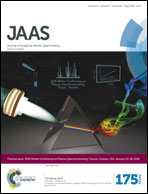Determination of tantalum from tantalum oxide nanoparticle X-ray/CT contrast agents in rat tissues and bodily fluids by ICP-OES†
Abstract
Accurate and precise means for quantifying Ta in tissues, bodily fluids, and bone is critical in understanding anticipated safety-profiles for tantalum oxide (TaO) nanoparticle-based X-ray/CT diagnostic imaging agents and has prompted the development of three digestion methods which are the focus of this work. Spike recovery studies were employed to evaluate bias, precision, and sample matrix effects in the quantification of Ta in (1) liver, blood and femur by microwave-assisted digestion, (2) urine by open-beaker digestion, and (3) carcass, liver and feces by dry-ash digestion. All analyses were performed with inductively coupled plasma optical emission spectrometry (ICP-OES). Spike recoveries were 98.5–102.3% for all biological matrices except femur (91.6%); however, a modified version of the original microwave digestion procedure improved the recovery of Ta in femur to 103.8%. Precision of spike recovery reported as one standard deviation ranged from 0.1 to 3.8% for within-run and from 0.5 to 3.3% for overall recovery depending on the tissue type and digestion method. Limit of detection (LOD) was 0.006 to 6 μg Ta per g and limit of quantification (LOQ) was 0.02 to 20 μg Ta per g depending on the method. The presented methods were applied to the determination of Ta in liver, kidney, spleen and carcass from an in vivo TaO nanoparticle retention study, and the results for percent injected dose (% ID) of Ta retained are given.


 Please wait while we load your content...
Please wait while we load your content...